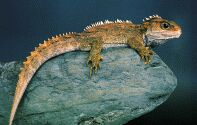The tuatara is an endemic species to New Zealand that has survived for 220 million years, which is in danger of extinction that will increase due to global warming, because at high temperatures only males are born

Climatic changes such as global warming will leave only males among an entire species of ancient lizard-like species by the end of the century. This prediction is attributed to the lizard species Sphenodon guntheri tuatara, a lizard-like creature that lives in New Zealand and has been walking on the earth for 225 million years (which is why it is sometimes called a "walking fossil"). This is the only reptile species that survived from an ancient family of reptiles - sphenodontia. The tuatara is an endemic species to New Zealand, which is in danger of extinction (today the estimated number of individuals belonging to this species is only in the thousands). In fact, the tuatara includes two related species, guntheri and punctatus, among which the guntheri tuatara species is rarer and lives only on Brother's Island. The tuatara feed on insects, are active at night, the males are up to 60 cm long and weigh 1 kilogram. They are long-lived - up to 70 or even 100 years.
An increase in temperatures may shift the ratio between males and females in reptile species. Simulations simulating an increase in temperature and reported in the July issue of the journal Proceedings of the Royal Society indicate that by the year 2080, temperatures in the region will rise so high that they will completely prevent the hatching of females. This of course means a death sentence for a species that is already in danger of extinction, report the researchers, who recommend capturing the tuatara lizards and moving them to a cooler island.
Tuatara lizards are famous both for being a species of such ancient origin and because they are equipped with a third eye (!) The third eye can be seen under the skin of young tuatara. After four to six months, the eye area is also covered with scales. The third eye absorbs ultraviolet radiation during the first months of the tuatara's life. Young tuatara produce vitamin D with the help of radiation and use this vitamin in their growth process.
Sources

7 תגובות
sparrow:
Evolution never "goes into action" because it is always in action.
It has no purpose and the fact that species change and consequently "adapt themselves" is a result of the laws of probability.
The species does not always "succeed" in adapting itself and then it really becomes extinct, but there is no question of good and bad here at all and to say that it deserves it is meaningless.
When the sun swells to a red giant, it is most likely that no life form on Earth will be able to "adapt itself" and then all animals will vacate the arena "as a failed species" but no other animal will take their place.
Humans are a part of nature and like any other creature they depend on their adaptation to their living environment. If the environment changes too much they will not survive. Therefore - if they want to survive - they must intervene to prevent too great a change in the environment. In general - what is "do not interfere"? The whole life of any creature is but a continuous "interference".
A. If there is an event like warming, or cooling, doesn't that mean that evolution has to come into action? The individuals that produce females despite the heat will reproduce, and the sacred balance will be restored.
B. This species must have already gone through hot or cold periods.
third. If they are not able to survive a heat period, then maybe they should not survive and it is better that they vacate the area as a failed species like many other species. This is evolution among other things.
don't interfere
I found the news on the evening of 7.8. It is said there that a 111-year-old tuatara male lived in a pen in a museum in New Zealand since 1970 but showed no interest in sex until recently a cancerous tumor was removed from his penis and then mated with a 70-80 year old female (one of three there) who laid 12 eggs. Not a word about the danger of extinction and the hatching of males only.
?œ?›?•?œ ?”?–?—?œ?™? ?¢?“ ?›?ž?” ?©?™?“?•?¢ ?œ?™, ?›?•?œ?œ ?¦?'?™? . ? ?'?' ?ž?™?©?”?• ?–?” ?œ? ?›?–?” ?¤?©?•?˜ ?œ? ???•?£ ?'?™?¦?™? ?©?œ ?ž?™?Ÿ ?©?œ? ?•?œ?“?¢?× ?©?'? ?“?•?¨ ?”?”?ž?©?š ?œ? ?™?•?›?œ ?œ?”?×?§?™?™? ?œ?œ? ?”?¢?–?¨?” ?©?œ? ?•:\
Wait, crocodiles also have a section like this? Right?
The easiest way is to collect the eggs and store them in a refrigerator
controlled.
I am surprised that I read in a daily newspaper one of the last days, news about the danger of extinction of the tuatara, but without mentioning the problem of the females. Can anyone confirm this?
And as a result - there is no doubt that the source of the information is one (on the science website and in the newspaper) - but what is it?